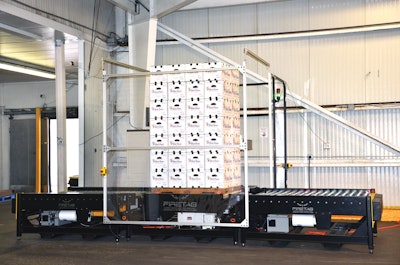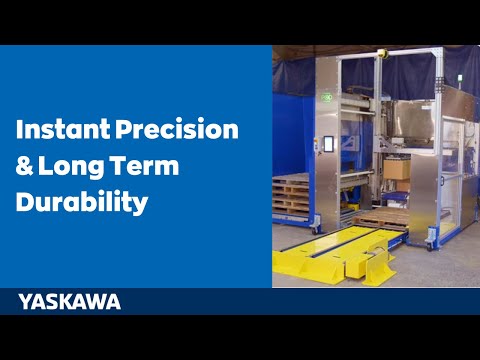What’s a poor produce shipping and growing company to do when the coding and marking system it needs isn’t available in the marketplace? Develop its own, of course. And then, for good measure, it spins off a technology arm to market its new invention.
That’s pretty much what happened when management at Wishnatzki Farms—based in Plant City, FL, they’re the largest producer and shipper of strawberries in Florida—decided they needed a better way to put a PTI-compliant mark (see sidebar) on palletized produce. They call their ingenious device FireTag.
“Nothing available in the marketplace could handle palletized cases,” explains Rob Ogilbee, CFO of VirtualOne, the Wishnatzki Farms-owned technology division set up to market and sell FireTag. “A number of solutions were available for in-line labeling of individual cases as they pass by. But we have a lot of products that come in from the field already palletized. The pallets go into a centralized cooler facility and come out when it’s time for them to go out to the retail channel. It just didn’t make sense to break down that pallet, execute the PTI-compliant identification, and then rebuild the pallet.”
And so it was that FireTag was born (see video at www.bit.ly/pwe00430). It features a camera-guided laser system mounted on a servo-driven three-axis carriage that burns a GS1-128 bar code plus human-readable information that is all compliant with PTI guidelines.
Essentially the system consists of three stations, the first of which is an input station. Here a scanner reads a pallet’s bar code. This bar code, applied to a pallet when it enters the centralized cooler facility, contains several key pieces of information:
•
GTIN, or Global Trade Item Number (this number identifies the product’s identity, such as “large green peppers”)
•
the kind of box the product is in
•
the number of containers on the pallet
•
the lot number.
The camera scanning the bar code is networked to an Advantech PC in the system’s touchscreen that coordinates with the Yaskawa PLC responsible for motion—i.e., conveying the pallet onto the turntable, turning the turntable, and moving the carriage on which the laser coder is mounted. The PC also interfaces with the laser coder so that the correct GTIN and lot # get printed on the boxes. The PC also determines, depending on which GTIN is in the bar code, how many boxes are stacked on the pallet and the precise location of the spot on which laser coding is to be done. In other words, the PC “tells” the laser what information to print and where to print it.
Data exchange
Once this rather complex exchange of data is complete, the PLC signals the roller conveyors to move the pallet onto the turntable in the second and central station of the system. Here is where the laser coding is done by a Macsa laser mounted on the three-axis carriage that moves the laser around the pallet as required. Based in Spain, Macsa’s line of laser coders are available in the U.S. from ID Technology, a ProMach division. Recent software improvements to the control system and an upgraded 80-Watt laser have decreased the cycle time and marking speed of each box to less than one second. All movements are controlled by Yaskawa servo motors, of which there are a total of seven.
“The Yaskawa 5 intelligent motion system has proven very capable at coordinating motion,” says Bob Pitzer, owner of 4FX Design and the designer and builder of the FireTag system. “Remember, when you’re moving the laser around the pallet on that rather long arm or carriage, there’s considerable vibration. This could affect print quality. One thing the Yaskawa system does is automatically compensate for all that vibration. So it does a bunch of funky stuff with the servo motors to maker sure the laser is not vibrating as it etches a box. It’s pretty advanced controls stuff.”
Pitzer continues. “Some portion of the pallet may lean out a little from the rest. But with laser printing, you have to keep the right distance between the laser and the surface being etched. So one axis of motion controlled by the Yaskawa system is the movement of the laser print head toward or away from the boxes on the pallet. In this way, the distance between the printer and the substrate being printed is always optimized.”
It’s important to point out that an essential component in the FireTag system is the CodeStream “patch” on each box. A translucent, water-based coating applied during the box-converting process, it produces a high-quality mark when exposed to a low-power laser. Developed by Fujifilm Hunt Chemicals, the CodeStream mark is tamper-evident, deterring product counterfeiting and preventing the modification of product information such as expiration dates, serialized numbers, and lot codes. It does not release VOCs, solvents, or airborne particulates when the laser hits it. It’s a marking technology that is consistently readable, verifiable, and unalterable.
Footprint
And how much space does the FireTag occupy in a centralized cooler facility? The infeed and outfeed roller conveyors, the automated turntable, and the carriage on which the laser is mounted occupy the same amount of linear space as six pallets. And because the system is completely modular, it moves easily from one facility to another should harvest schedules require it.
Ogilbee says that FireTag, compared to the “peel-and-stick” labeling approach that is generally the most widely used alternative, has a number of advantages. “For one thing, produce doesn’t come into the warehouse cooler in a steady stream. It ebbs and flows. So with a peel-and-stick approach you have a work force that works hard for an hour or so and then sits around for a couple of hours until another grower shows up with produce. You don’t have that personnel deployment problem with the FireTag solution.
“Also, the laser can be programmed to make whatever mark you want,” Ogilbee continues. “You don’t even keep any labels in inventory, so there’s never a worry about throwing labels away should they become somehow outdated. You mark on the fly, anything from graphics to bar codes to human-readable copy.”
As for speed, each box is coded in 1⁄3 of a second. So from the time marking of a pallet begins to the time it can start marking the next pallet is about two minutes. Pitzer says he is now working on a version of the system where laser marking is done by two carriage-mounted laser coders, one on each side. This would essentially cut in half the time it takes to code a pallet.
One laser or two, Ogilbee is pretty sold on the benefits offered by the FireTag concept.
“Complying with PTI guidelines will bring a cost,” says Ogilbee. “But when you balance the cost against what it brings you, it’s a cost worth absorbing because if there is a recall, you can pinpoint the source much more quickly and reliably. The nice thing about FireTag is that it keeps the cost of complying to a minimum.”





















